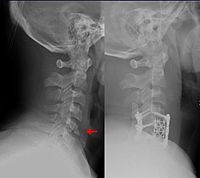
Photo from wikipedia
INTRODUCTION As combat-related trauma decreases, there remains an increasing need to maintain the ability to care for trauma victims from other casualty events around the world (e.g., terrorism, natural disasters,… Click to show full abstract
INTRODUCTION As combat-related trauma decreases, there remains an increasing need to maintain the ability to care for trauma victims from other casualty events around the world (e.g., terrorism, natural disasters, and infrastructure failures). During these events, military surgeons often work closely with their civilian counterparts, often in austere and expeditionary contexts. In these environments, the primary aim of the surgical team is to implement damage control principles to avert blood loss, optimize oxygenation, and improve survival. Upper-extremity vascular injuries are associated with high rates of morbidity and mortality resulting from exsanguination and ischemic complications; however, fatalities may be avoided if hemorrhage is rapidly controlled. In austere contexts, deployed surgical teams typically include one general surgeon and one orthopedic surgeon, neither of which have acquired the expertise to manage these vascular injuries. The purpose of this study was to examine the baseline capabilities of general surgeons and orthopedic surgeons to surgically expose and control axillary and brachial arteries and to determine if the abilities of both groups could be increased through a focused cadaver-based training intervention. METHODS This study received IRB approval at our institution. Study methods included the use of cadavers for baseline assessment of procedural capabilities to expose and control axillary and brachial vessels, followed by 1:1 procedural training and posttraining re-assessment of procedural capabilities. Inferential analyses included ANOVA/MANOVA for within- and between-group effects (P < .05). Effect sizes were calculated using Cohen's d. RESULTS Study outcomes demonstrated significant differences between the baseline performance abilities of the two groups, with general surgeons outperforming orthopedic surgeons. Before training, neither group reached performance benchmarks for overall or critical procedural abilities in exposing axillary and brachial vessels. Training led to increased abilities for both groups. There were statistically significant gains for overall procedural abilities, as well as for critical procedural elements that are directly associated with morbidity and mortality. These outcomes were consistent for both general and orthopedic surgeons. Effect sizes ranged between medium (general surgeons) and very large (orthopedic surgeons). CONCLUSION There was a baseline capability gap for both general surgeons and orthopedic surgeons to surgically expose and control the axillary and brachial vessels. Outcomes from the course suggest that the methodology facilitates the acquisition of accurate and independent vascular procedural capabilities in the management of upper-extremity trauma injuries. The impact of this training for surgeons situated in expeditionary or remote contexts has direct relevance for caring for victims of extremity trauma. These outcomes underscore the need to train all surgeons serving in rural, remote, expeditionary, combat, or global health contexts to be able to competently manage extremity trauma and concurrent vascular injuries to increase the quality of care in those settings.
Journal Title: Military medicine
Year Published: 2022
Link to full text (if available)
Share on Social Media: Sign Up to like & get
recommendations!